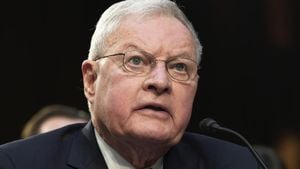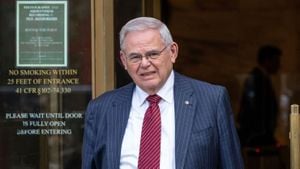NASA's Boeing Starliner mission has hit significant hurdles since its historic launch on June 5, 2024. The spacecraft successfully docked with the International Space Station (ISS) but has since faced alarming issues related to its propulsion system, raising doubts about the safety of returning its crew.
Astronauts Barry "Butch" Wilmore and Sunita "Suni" Williams were initially scheduled for just over a week aboard the ISS, but they have now spent over two months, with the prospect of delays stretching even longer. With the risks involved inadequately assessed, both NASA and Boeing are contemplating alternative plans for their return.
If the Starliner is deemed unsatisfactory for re-entry, the astronauts might fly back to Earth aboard SpaceX's Crew Dragon, which has been reliable for previous missions. According to NASA officials, alternatives are under consideration to deal with the unforeseen delays.
Reports suggest the Starliner may be too unreliable to bring the astronauts home safely, prompting speculation about their potential rescue. Upcoming plans could involve both the delayed SpaceX Crew-9 and potentially even opting for Russian Soyuz spacecraft to return the astronauts instead.
Ken Bowersox, NASA's associate administrator for space operations, remarked, "I don't think we're too far away from making [a decision on the Starliner] call. We know at some point we need to bring Butch and Suni home." NASA has carefully determined more time is needed to finalize plans after delays for the Crew-9 launch.
The Crew-9 mission, which was initially scheduled for August 18, had to be postponed, leaving the Starliner astronauts with no immediate return. NASA’s strategy seems focused on ensuring every safety measure is assessed before launching any returning spacecraft.
Both astronauts have bravely adapted to their extended stay aboard the ISS, contributing to scientific experiments and daily station maintenance. They’ve had to adjust, utilizing spare clothing since they left essentials behind to accommodate new equipment.
This delay raises pressing questions about Boeing and its partnership with NASA. Critics are questioning if the airline giant can still meet the demands of crew rotations to the ISS after these setbacks.
Reports indicate Boeing has incurred substantial financial burdens during the Starliner's development phase, tallying at least $1.5 billion beyond initial budget estimates. Despite this, Boeing maintains confidence, declaring, "Boeing remains confident in the Starliner spacecraft and its ability to return safely with crew."
Imagining their current living conditions, the two seasoned astronauts still convey humor and positivity, painting the ISS as both their home and workplace. Wilmore recently described his time there as, "It's wonderful place to be, live and work," underlining the astronauts’ capacity to adapt to less than optimal situations.
Despite the positive atmosphere aboard, the uncertainty surrounding the Starliner's reliability has caused unease among space enthusiasts and stakeholders. NASA's indecision may echo back to previous tragedies faced by its programs, prompting analysts to recommend careful consideration over embarrassment.
NASA's reliance on partnerships was initially aimed to usher rapid advancements, turning the U.S. back toward the forefront of space travel. The current delays, creating technical and logistical predicaments, might find both agencies questioning the sustainability of their collaboration.
SpaceX has quickly established itself by conducting multiple successful crewed missions to the ISS consistently, reinforcing its position as the go-to supplier for NASA. The contrasting reliability of SpaceX raises accountability questions for Boeing as they struggle with the Starliner’s integration and operational shortcomings.
Historically, America had relied on Russian spacecraft to shuttle astronauts to the ISS post-Shuttle retirement, creating unique international collaborations. The ISS, managed by NASA and Roscosmos among other agencies, wasn’t meant to hinge upon prolonged uncertainties due to underperformance by one of its primary allies.
Space enthusiasts are eagerly watching for any news on whether the Starliner will fulfill its badge of honor to replace the Space Shuttle, holding expectations for the correctness of Boeing’s operations and performance. The success of the Starliner mission is seen as pivotal to NASA’s aspirations to return lunar astronauts and, eventually, go on to Mars.
With the planned return for Butch and Suni still up in the air, the real impact looms over NASA’s upgraded capabilities. If these delays mean calling upon SpaceX's vehicle, the potential operational circumstances may lead to larger reverberations on contracts and future missions.
The pace at which successful missions deploy astronauts to destinations beyond Earth is already being watched savagely by the global space community awaiting the horizon of human spaceflight. Space agencies are weighing whether the risk of human lives will sideline the progress achieved over the decades.
The ISS stays up for its purpose as research grounding, seeing everyday use for science rather than just transportation. Both astronauts have continued their routine amid the uncertainty, checking and outputting data – adopting lives encapsulated within their scientific objectives.
NASA officials continue to review all available options, determined not to jeopardize crew safety. The path of progress hangs on ensuring return protocols navigate around complex failures and delays for SpaceX and Boeing alike.
While the details surrounding the Starliner remain convoluted, one thing is certain: the resolution of the astronauts' return issues is among the biggest dilemmas facing human spaceflight today. Observers are calling for heightened accountability and transparency from Boeing as their fate and future exploration paths rest precariously on this awaiting decision.
NASA officials expressed they want to maintain their timeline yet understand the risks involved, emphasizing the importance of overcoming recent hurdles to avoid repeating past mistakes. They’ve reassured the public they are investing every effort needed to secure the best possible outcome for Butch and Suni.
The astronauts’ mission offered hopes for launching astronauts to orbit from U.S. territory, but the current delays are causing complicated reflections on the industry. The questions surrounding the Starliner reflect not only on Boeing but on the reliability of commercial partnerships facilitating NASA's space exploration efforts.
Will the Starliner eventually make history, or will it fall to another vehicle to rescue its astronauts? This question remains pivotal as the deadline for their return looms large and the world anxiously watches the decisions made behind NASA's closed doors.



